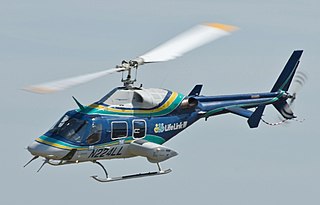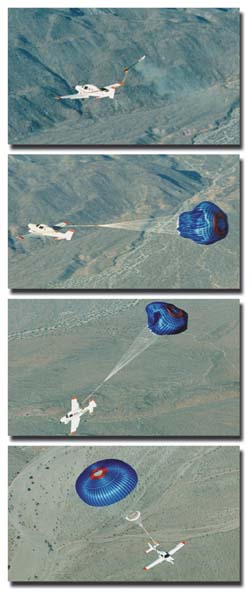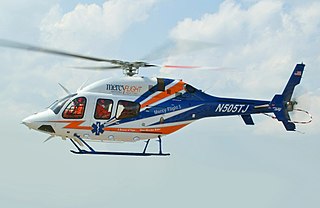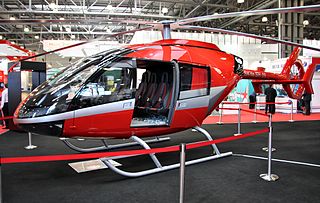
The Bell 222 is an American twin-engine light helicopter built by Bell Helicopter. The Bell 230 is an improved development with different engines and other minor changes.

The Bell 407 is a four-blade, single-engine, civil utility helicopter. A derivative of the Bell 206L-4 LongRanger, the 407 uses the four-blade, soft-in-plane design rotor with composite hub developed for the United States Army's OH-58D Kiowa Warrior instead of the two-blade, semi-rigid, teetering rotor of the 206L-4.

The Kaman HH-43 Huskie is a helicopter developed and produced by the American rotorcraft manufacturer Kaman Aircraft. It is perhaps most distinctive for its use of twin intermeshing rotors, having been largely designed by the German aeronautical engineer Anton Flettner.

A ballistic parachute, ballistic reserve parachute, or emergency ballistic reserve parachute, is a parachute ejected from its casing by a small explosion, much like that used in an ejection seat. The advantage of the ballistic parachute over a conventional parachute is that it ejects the parachute canopy, causing it to open rapidly, thus making it ideal for attaching to light aircraft, hang gliders and microlights, where an emergency may occur in close proximity to the ground. In such a situation, a conventional parachute would not open quickly enough.

The Bell 429 GlobalRanger is a light, twin-engine helicopter developed by Bell Helicopter and Korea Aerospace Industries. The first flight of the prototype took place on February 27, 2007, and the aircraft received type certification on July 1, 2009. The Bell 429 is capable of single-pilot IFR and Runway Category A operations.

The Bell 214 is a medium-lift helicopter derived from Bell Helicopter's ubiquitous UH-1 Huey series. The Bell 214ST shares the same model number, but is a larger, much-modified twin-engine derivative.

The Schweizer 330 and S333 are turbine-powered developments of the Schweizer 300 light piston-powered helicopter. As of 2007, only the Schweizer 333 remains in production. In February 2009, the 333 was rebranded as the Sikorsky S-333. In 2018 the Schweizer R.S.G. bought the Schweizer Aircraft from Sikorsky Aircraft and it was rebranded as Schweizer S333 again.

The Airbus Helicopters H155 is a long-range medium-lift passenger transport helicopter developed by Eurocopter from its Dauphin family for civil aviation use. It is a twin-engined aircraft and can carry up to 13 passengers along with 1 or 2 crew, depending on customer configuration. The helicopter is marketed for passenger transport, offshore support, VIP corporate transport and casualty transport duties. In 2015, the EC155 was formally renamed to the H155, in line with Eurocopter's corporate rebranding as Airbus Helicopters. It was succeeded in the product line by the Airbus Helicopters H160.

The Westland Westminster was a British helicopter of the 1950s from Westland Aircraft. A large cargo design, it was powered by two turboshaft engines driving a single, five-bladed rotor. Initially unclad, the all-metal airframe was later enclosed in a fabric covering. Designed and built as a private venture without government assistance, it was cancelled when Westland took over rival helicopter producers and their more advanced projects.

The Sikorsky S-75 was a proof-of-concept all-composite helicopter. Sikorsky Aircraft used all-composite materials to replace metal to provide greater strength, lighter weight, lower manufacturing costs, and reduce maintenance costs.

The Robinson R66 is a helicopter designed and built by Robinson Helicopter Company. It has five seats, a separate cargo compartment and is powered by a Rolls-Royce RR300 turboshaft engine. The R66 is slightly faster and smoother than the piston-powered Robinson R44 from which it is derived. The R66 received both type and production certificates from the U.S. Federal Aviation Administration (FAA) on October 25, 2010.
The Famà Kiss 209M is an Italian ultralight two-seat helicopter, built from composite materials around a steel frame and with an optional retractable undercarriage. The moniker "Kiss" stands for "keep it stupidly simple", reflecting the philosophy of its designer, Nino Famà.

The Bell 525 Relentless is an American super-medium-lift helicopter, under development by Bell Textron. The new model was unveiled at the 2012 Heli-Expo in Dallas, Texas in February 2012. It first flew on 1 July 2015.

The Kopter AW09, rebranded in Leonardo AW09, is the Leonardo small civil helicopter division's five-to-eight seat, single-engine multirole helicopter which is currently under development at Kopter’s facilities. It is a clean-sheet design amongst a market sector dominated by decades-old airframe designs.

The Airbus Helicopters H160 is a medium utility helicopter developed by Airbus Helicopters. Formally launched at Heli-Expo in Orlando, Florida on 3 March 2015, it is intended to replace the AS365 and EC155 models in the firm's lineup. In June 2015, the first test flight took place. It received its EASA type certification in July 2020, and first deliveries were in December 2021.

První brněnská strojírna Velká Bíteš, a. s. is a Czech engineering and manufacturing company. It focuses mainly on the development, testing, and production of devices for the aircraft industry. Together with PBS Energo, a.s.; PBS Brno, a.s. and PBS Aerospace Inc., PBS VB is a member of PBS GROUP, a.s.
The Arrow Coax Livella Uno is a German helicopter under development by Arrow Coax Ultra Light Helicopter of Hornhausen and introduced at the AERO Friedrichshafen airshow in 2015. The aircraft is intended to be supplied as a kit for amateur construction.
The IRI T250A is an Italian helicopter that was designed and produced by Italian Rotors Industries of Aprilia, Lazio and introduced in 2015. Now out of production, when it was available the aircraft was supplied complete and ready-to-fly.

Italian Rotors Industries Srl (IRI) was an Italian aircraft manufacturer based in Aprilia, Lazio. The company specialized in the design and manufacture of helicopters in the form ready-to-fly aircraft.
The PBS TS100 is a small turboshaft engine produced by a Czech turbine engine manufacturer PBS Velká Bíteš. The engine with a maximum power of 241 hp (180 kW) has been developed for light helicopters weighing up to 2,204 lb (1,000 kg).


















